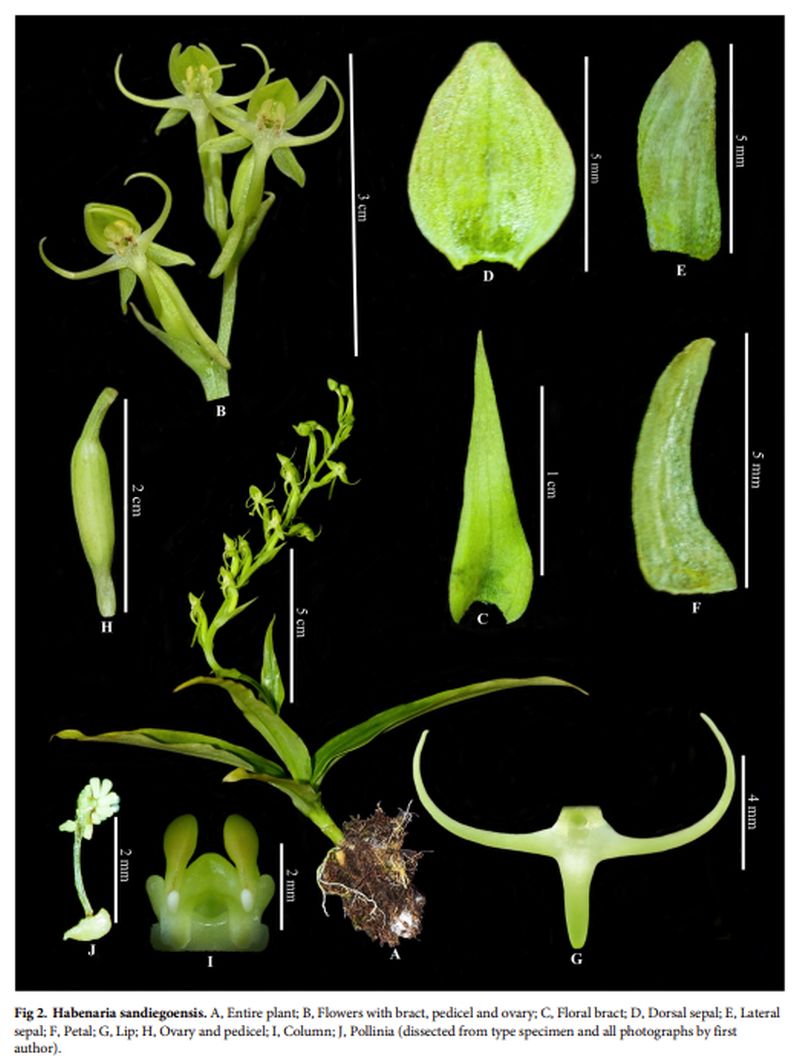

Habenaria sandiegoensis Raskoti 2019
LCDP Photo/in situ photo by © Bhakta Bahadur Raskoti and The Molecular phylogeny and morphology reveal a new epiphytic species of Habenaria (Orchidaceae; Orchideae; Orchidinae) from Nepal Website


 EARLY
EARLY 
Common Name The San Diego Habenaria
Flower Size .6" [1.5 cm]
Found in Nepal in mixed deciduous cloud forests in cloudy and moist areas, at elevations around 1600 meters as a small sized, cool growing epiphte with multiple undivided, rhizome-like, cylindric oblong, fleshy, partly covered by dense white, soft, wooly hairy tuber giving rise to an erect, stout stem carrying 3 to 5, basal, oblong-lanceolate to broadly oblanceolate, herbaceous, margin entire, apex acute, contracted below into an amplexicaul base leaf that blooms in the summer and early fall on an erect, terminal, racemose, peduncle 1.6 to 3.2" [4 to 8 cm] long, cylindric, provided with a single ovate-lanceolate acuminate, or absent sterile bract, rachis 3.2 to 4.8" [8 to 12 cm] long, 7 to 15 flowered inflorescence with greenish, lanceolate, acuminate, shorter than the ovary floral bract.
"Interestingly, Habenaria sandiegoensis has creeping roots that are exposed in air and its tubers are multiple growing in the majority of population, which look somewhat callus-shaped and rhizome like (in general outline) and covered by dense woolly hairs, the character similar to some epiphytic ferns such as Phlebodium aureum." Raskoti & Ale 2019
"Habenaria sandiegoensis is distinctive among its closely related taxa being the only species having an epiphytic habit. It is close to Habenaria plurifoliata (a Chinese species from Guangxi and Yunnan province), with which it shares basal clustered leaves (rosette phyllotaxy) and filiform lateral lobes of lip, but the new species can be distinguished from the later by having multiple growing callus-shaped tubers, smaller stature with a short stem, 3 to 5, oblanceolate leaves (vs. 6 to 10, linear-lanceolate), lateral lobes of lip spreading upwards, spur equal or shorter than ovary and pedicel (in very rare case, spur of an apical flower equals or slightly exceeds the ovary and pedicel). In morphology, H. iyoyensis is somewhat similar to H. sandiegoensis, but according to Chen et al., the former has several sterile bracts, spur longer than ovary and pedicel, lateral lobes of lip usually not spreading upward. In molecular analyses H. iyoyensis and H. sandiegoensis were revealed as different species. Habenaria sandiegoensis is epiphytic in habit and has clustered leaves; in phylogenetic analyses it is clearly positioned within the terrestrial clade having taxa with clustered leaves and filiform lateral lobes. However, in the floral morphology such as shape of lateral sepal, petal, lip and column, H. sandiegoensis looks closer to Habenaria propinquior but the later has opposite leaves and white flowers." Raskoti & Ale
Synonyms
References W3 Tropicos, Kew Monocot list , IPNI ;
--------------------------------------------------------------------------------------------------------------------------